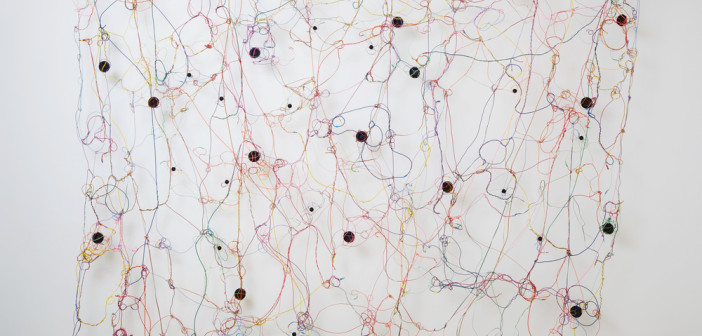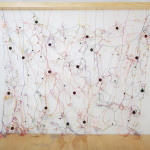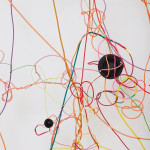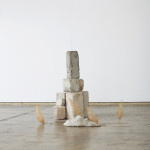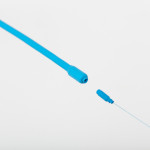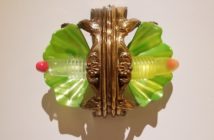Almost all institutions run into this problem at some point. Those that are smaller or offer programming more likely to draw artists or art-lovers usually aren’t faced with the task of instilling the etiquette of art-viewing to a larger, generalized public. To its credit, the deCordova uses many tried and true methods to delineate where, in this exhibition, it is okay to interact. But even I found myself confused when approaching a small maple box in the center of the room, markedly more static than the sculptures surrounding it which appear fragile enough to fall apart if looked at the wrong way. (Apparently you were supposed to open the box and would be greeted with whispers of “I love you” that slowly crescendo into a chorus. I had trouble finding the wall text instructing that it was okay to do so.) But on the whole, the museum does a great job of offering family-oriented programming and a space that allows for the kind of exploration that you are more likely to find in a science museum. Granted some of these pieces will be the perfect kind for engaging with in that manner, but the entirety of this exhibition makes that atmosphere inherently misleading.
And yet being forced to reflect upon all of this proves just how powerful some of this work is. Much of Swartz’s intent is communicated through placing equal amounts of importance of each element used. She joins structurally disparate components and dichotomous concepts but unfortunately the balance doesn’t always immediately coalesce. When it does, however, you appreciate the complexity with which she can mix tender sentiment and formal unease. The best example of this is Lean, arguably the strongest piece of the exhibition and also appears as the most formally bare and technically difficult to achieve. It consists of a single vertical steel rod—attenuated to a thin point at the floor and bending under its own weight—sloping up and leaning close to the wall. But they never touch. Instead, the rod hovers a mere centimeter from the wall, trembling from the hidden magnetic force keeping it in place. Its fragile nature and rather smart bodily scale make you completely and anxiously aware of yourself. Here you begin to detect that your observation alone has the power to destroy most of her displayed work.
The success of Swartz's sculptures and our payoff come when the viewer becomes increasingly attuned like this to its well-being. The final contradiction comes when you realize, perhaps unexpectedly, that this is achieved as your attention shifts off of the work and onto the people and space around it. So when noticing that my face and stance increasingly began to match that of that gallery attendant, I was able to settle into a pleasurable mix of frustrated worry, sharpened awareness and a desire to touch.
- Julianne Swartz, Loop, 2010 wire, speakers, electronics, and 8-channel composition. 130 x 140 x 10 inches Collection of Jean and Colette Cherqui, Paris
- Julianne Swartz, Loop detail, 2010 wire, speakers, electronics, and 8-channel composition. 130 x 140 x 10 inches Collection of Jean and Colette Cherqui, Paris
- Julianne Swartz, Surrogate (JS), Surrogate (KRL), Surrogate (ARL), 2012 cement, mica, and clock movements JS: 68 x 18 x 12 inches, KRL: 72 x 24 x 14 inches, ARL: 40 x 17 x 8 inches Courtesy of the artist and Josée Bienvenu Gallery
- Julianne Swartz, Obstacle, 2007 cement, battery, stainless steel wire, plastic and clock movement. 39 x 34 x 34 inches Courtesy of the artist and Josée Bienvenu Gallery
- Julianne Swartz, Blue Corner Reach detail, 2006 magnets, plastic and thread. 40 x 60 x 20 inches Courtesy of the artist and Josée Bienvenu Gallery
DeCordova Museum and Sculpture Park
Curated by Rachael Arauz, Julianne Swartz: How Deep Is Your is the first selected survey of the artist’s installations and sculpture. It is on view now through December 30 at the deCordova Sculpture Park and Museum. A tour of the exhibition with the curator will occur on October 27 at 3pm.

